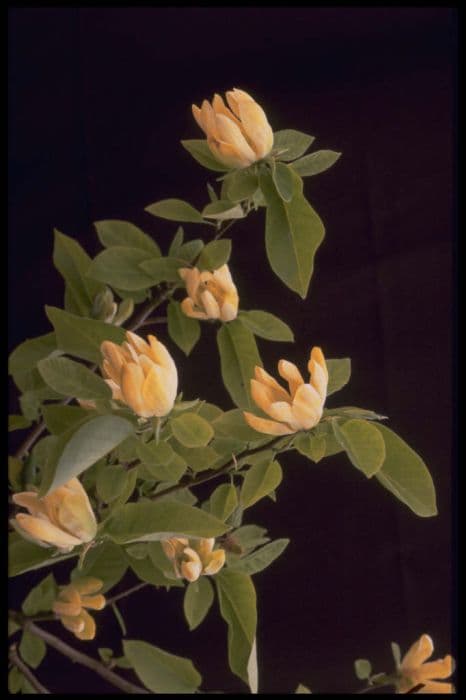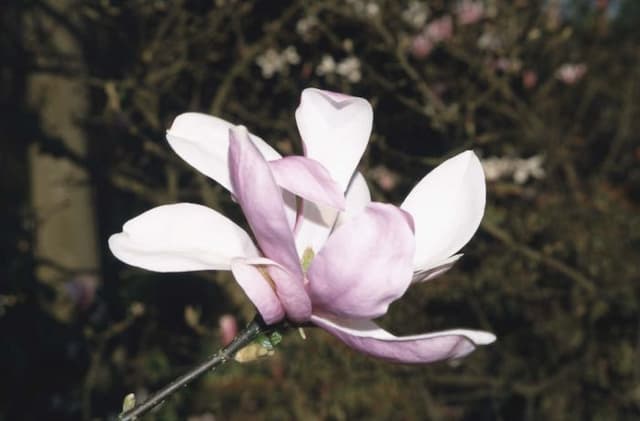Tulip tree Magnolia 'Hot Lips'

ABOUT
The Magnolia 'Hot Lips' is a striking plant known for its large and showy flowers. The blossoms are a distinctive feature, with petals that are white inside, while the outside boasts a bold, contrasting reddish-pink blush, which gives the plant its memorable 'Hot Lips' moniker. These flowers can appear cup-shaped or saucer-like and unfurl from velvety buds. With a rich fragrance, the blooms are a sensory delight in both sight and scent. The leaves of Magnolia 'Hot Lips' are glossy and leathery in texture, with a deep green hue that creates a lush backdrop for the dramatic blossoms. The overall appearance of the plant exudes elegance and makes it a captivating choice for ornamental purposes in a variety of garden settings.
About this plant
 Names
NamesSynonyms
Tulip Magnolia, Saucer Magnolia, Japanese Magnolia.
Common names
Magnolia 'Hot Lips'
 Toxicity
ToxicityTo humans
Magnolia 'Hot Lips' is generally considered to be non-toxic to humans. There are no widely recognized symptoms of poisoning from ingesting any part of this plant, as it is not known to contain harmful substances in quantities that would typically cause human toxicity. However, as with any plant material, individual reactions may vary, and it's prudent to avoid ingesting plant parts that are not commonly recognized as food.
To pets
Magnolia 'Hot Lips' is also considered to be non-toxic to pets. It is not known to cause poisoning in animals such as dogs and cats, and there are no common symptoms of toxicity associated with ingesting this plant. While the magnolia is generally safe, it is always a good practice to monitor pets and prevent them from eating plants, as individual reactions can vary, and some pets may have sensitivities or allergic reactions.
 Characteristics
CharacteristicsLife cycle
Perennials
Foliage type
Deciduous
Color of leaves
Green
Flower color
Mixed
Height
20 feet (6 meters)
Spread
15 feet (4.5 meters)
Plant type
Tree
Hardiness zones
5
Native area
Southeastern United States
Benefits
 General Benefits
General Benefits- Ornamental Appeal: Magnolia 'Hot Lips' has large, vibrant flowers that add a splash of color and visual interest to any garden.
- Shade Production: The tree can provide shade in the garden, making it cooler and more pleasant during hot weather.
- Fragrance: The flowers emit a sweet and pleasant fragrance, which can enhance the sensory experience of a garden or outdoor area.
- Wildlife Attraction: Magnolia 'Hot Lips' can attract pollinators like bees, butterflies, and birds, thereby supporting local ecosystems.
- Longevity: Magnolias are known for their long life span and can provide beauty for many years with proper care.
- Seasonal Interest: The plant has seasonal changes from budding flowers in spring to lush greenery in summer and potentially colorful leaves in the fall.
 Medical Properties
Medical PropertiesThis plant is not used for medical purposes.
 Air-purifying Qualities
Air-purifying QualitiesThis plant is not specifically known for air purifying qualities.
 Other Uses
Other Uses- Magnolia 'Hot Lips' can be used as a natural fabric dye, offering hues ranging from green to brown depending on the mordant used.
- The wood of Magnolia 'Hot Lips' is sometimes utilized in fine woodworking for its grain and color, often for inlays or small decorative objects.
- Petal extracts of Magnolia 'Hot Lips' can serve as a component in natural perfumes or scented candles, capturing the plant's unique fragrance.
- The large leaves of the Magnolia 'Hot Lips' can be used in floral arrangements or as natural wraps for delicate items, adding an elegant touch.
- Fallen Magnolia 'Hot Lips' leaves can be collected and used to create eco-friendly mulch for garden beds, providing nutrients as they decompose.
- Seed pods from Magnolia 'Hot Lips' can be used for crafting ornaments or in artistic projects due to their unique structure and appearance.
- Magnolia 'Hot Lips' can act as a living fence or privacy screen when planted in a linear fashion, due to its dense foliage.
- Pressed flowers and leaves of Magnolia 'Hot Lips' can be featured in botanical art, preserving the plant's beauty in a long-lasting form.
- Petals of Magnolia 'Hot Lips' can be incorporated into custom-made potpourri mixes, contributing a natural aesthetic and subtle scent.
- During spring, the blooming flowers of Magnolia 'Hot Lips' can be floated in large decorative bowls of water as part of a simple and natural centerpiece.
Interesting Facts
 Feng Shui
Feng ShuiThe Magnolia is not used in Feng Shui practice.
 Zodiac Sign Compitability
Zodiac Sign CompitabilityThe Magnolia is not used in astrology practice.
 Plant Symbolism
Plant Symbolism- Perseverance: Magnolias are often associated with perseverance due to their hardy nature and ability to thrive for centuries.
- Dignity: The dignified beauty of the Magnolia flower represents a person's noble spirit and self-respect.
- Femininity: With its delicate, poised blooms, the Magnolia is commonly linked with the softness and beauty of femininity.
- Purity: The pure white color of some Magnolia flowers signifies purity and innocence.
- Nobility: In ancient China, Magnolia flowers were thought to represent nobility and were often associated with the aristocratic classes.
- Love of Nature: Because Magnolias are ancient plants that have withstood the test of time, they symbolize a deep appreciation for the natural world.
- Endurance: Similar to perseverance, the Magnolia's robustness through changing climates signifies endurance and staying power.
- New Beginnings: The arrival of Magnolia blooms in spring can symbolize new starts and fresh opportunities.
- Peace and Tranquility: The calmness that a Magnolia garden can evoke points towards a meaning of peace and tranquility in one's life.
 Water
WaterTo properly care for your Magnolia 'Hot Lips,' it's important to maintain consistent moisture in the soil but avoid waterlogging. Water the tree deeply every week during the first growing season to help establish roots. Provide about 5 gallons of water weekly for young trees, and increase the amount as the tree matures, keeping in mind that mature magnolias may need up to 20 gallons every two weeks, especially in dry conditions. During hot or windy weather, you may need to water more frequently. Reduce watering in fall before the first frost to help the plant harden off for winter.
 Light
LightMagnolia 'Hot Lips' prefers full sun to partial shade. It thrives when planted in a location where it can receive at least 4 to 6 hours of direct sunlight per day. An ideal spot would be one with morning sunlight and afternoon shade to protect it from the intense heat of the day.
 Temperature
TemperatureMagnolia 'Hot Lips' is best suited for USDA zones 7 through 9 and can tolerate temperatures down to about 0 degrees Fahrenheit but prefers temperate climates. The optimal temperature range for these magnolias is between 60 and 70 degrees Fahrenheit during the growing season. They should be sheltered from extreme cold winds and frost to prevent damage.
 Pruning
PruningPrune your Magnolia 'Hot Lips' in late winter or early spring before new growth appears to maintain the tree's shape and remove any damaged or diseased wood. Occasional thinning helps to allow light and air into the canopy, which can benefit the tree's health. Pruning every few years is typically sufficient unless shaping is required or to remove broken branches.
 Cleaning
CleaningAs needed
 Soil
SoilThe best soil mix for the Magnolia 'Hot Lips' is well-draining soil rich in organic matter with an acidic to neutral pH of around 5.0 to 7.0. A blend of loamy soil, peat moss, and compost is ideal, ensuring good aeration and moisture retention.
 Repotting
RepottingMagnolia 'Hot Lips' should be repotted every 2-3 years or when it outgrows its current pot. Transplant it in the spring before the new growth begins, choosing a pot only slightly larger than the previous one.
 Humidity & Misting
Humidity & MistingThe ideal humidity level for Magnolia 'Hot Lips' is moderate to high. While it can adapt to average humidity levels, it thrives with increased moisture in the air, mimicking its natural environment.
 Suitable locations
Suitable locationsIndoor
Place in bright, indirect light; avoid dry heat sources.
Outdoor
Full sun to partial shade, shelter from harsh winds.
Hardiness zone
7-9 USDA
 Life cycle
Life cycleThe life of a 'Hot Lips' Magnolia begins with seed germination, which occurs when conditions are warm and moist, usually in spring. After sprouting, the seedling goes through a juvenile stage where it grows rapidly, establishing a root system and foliage but not yet producing flowers. As it matures into an adult plant, the 'Hot Lips' Magnolia enters a flowering stage, typically in early spring, producing large, fragrant, pink and white flowers before the leaves appear. Following pollination, often by bees, the flowers develop into cone-like fruit that releases red seeds when mature. The plant enters a period of growth each year where leaves expand and it gains height and width, becoming a large shrub or small tree. As a perennial, the Magnolia 'Hot Lips' repeats its growth and reproductive cycle annually, with proper care and favorable conditions, for many years.
 Propogation
PropogationPropogation time
Spring-Early Summer
The most popular method of propagation for the Magnolia 'Hot Lips' is through semi-hardwood cuttings. This typically occurs in the summer when the plant's growth begins to harden but is not yet fully mature. A healthy stem of about 4 to 6 inches (10 to 15 centimeters) is selected and cut just below a leaf node. The lower leaves are removed, and the cut end may be treated with a rooting hormone to encourage root development. The cutting is then placed in a well-draining potting mix and kept in a humid environment until roots have formed, which could take several weeks. During this time, the cutting should be kept out of direct sunlight and the soil should remain consistently moist, but not waterlogged.



![Magnolia [Black Tulip]](/_next/image?url=https%3A%2F%2Fplants-admin.emdemapps.com%2Fimages%2Fplants%2F%2Fimages%2F604b590290fc7.png&w=640&q=75)


![Magnolia [Fairy Blush]](/_next/image?url=https%3A%2F%2Fplants-admin.emdemapps.com%2Fimages%2Fplants%2F%2Fimages%2F604b5a108e959.png&w=640&q=75)


